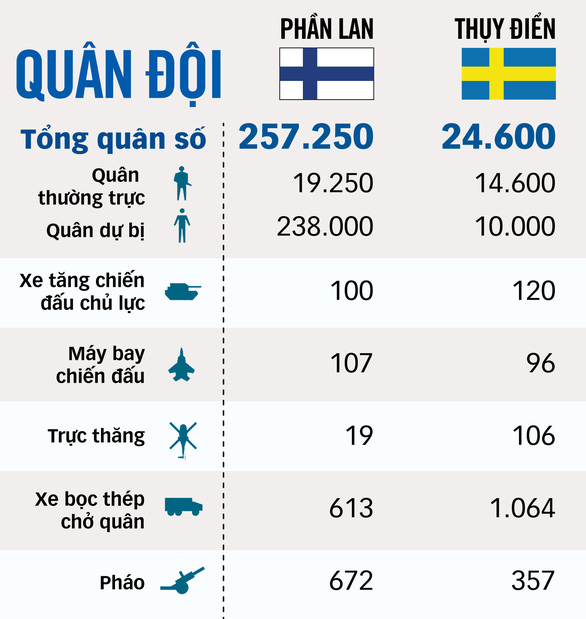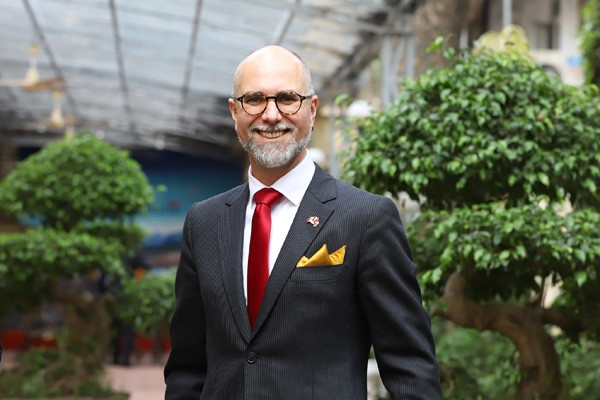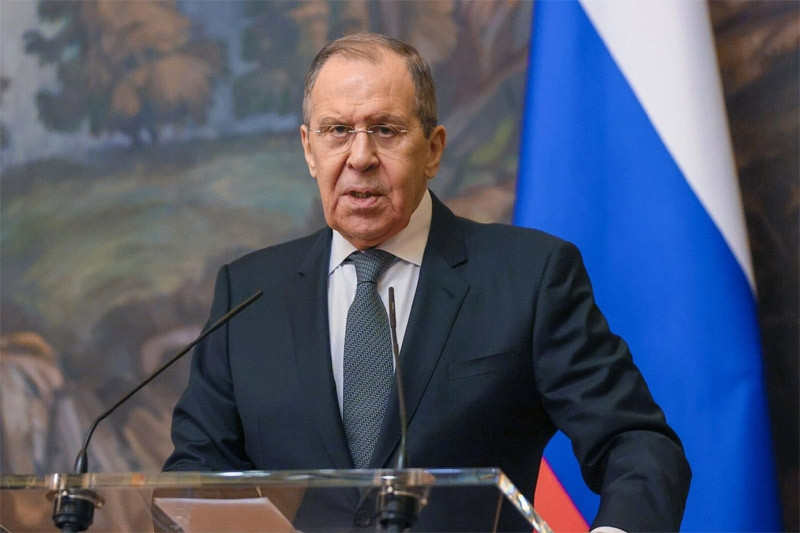The war in Ukraine and the new situation in Northern Europe

Source: BBC, IISS, Military Balance 2022 – Data: BAO ANH – Graphics: T.DAT
Earlier, on May 12, Finnish President Sauli Väinämö Niinistö and Prime Minister Sanna Marin issued a statement affirming their support for joining NATO.
Waiting for action of Sweden
In the Nordic region, similar to Sweden, Finland follows the policy of neutrality and is not a NATO member like Norway and Denmark. However, Finland remains on the alert for security as one of the few European countries that spends 2% of GDP on defense budgets and still works closely with NATO.
However, Russia’s attack on Ukraine has changed the security policy of Finland and Sweden because these two countries do not trust Russia and President Putin to respect their neutrality.
On the Swedish side, the Government’s Foreign and Security Policy Committee will meet on May 15 to decide whether to apply to join NATO and submit its conclusions to the National Assembly.
Prime Minister Magdalena Andersson’s Social Democrats, previously opposed to joining NATO, are now likely to change their stance. Prime Minister Andersson has asked the Swedish Parliament to convene to debate the issue on May 16. The Government can then make a decision without a vote.
Swedish Defense Minister Peter Hultqvist said joining NATO strengthens the overall defense of the Nordic region and will reduce the risk of attack for the three Baltic states – Estonia, Latvia and Lithuania – as well as the island Gotland of Sweden.
On May 17, Finnish President Niinistö will pay an official state visit to Sweden and will meet with King Gustav XVI and Prime Minister Magdalena Andersson. Observers predict that the two countries will issue a joint statement on cooperation and NATO accession on this occasion.
The Russian side reacted strongly to Finland’s announcement of joining NATO. Deputy Chairman of Russia’s Security Council Dmitry Medvedev, also a former president and prime minister, said Russia was “forced to strengthen (security) borders” if Finland and Sweden joined NATO. Medvedev also warned of the possibility that nuclear weapons could be deployed in the Baltic region because Russia “could be forced by circumstances”.
Following Finland’s move, Kremlin spokesman Dmitry Peskov stated that “Finland’s plan to join NATO poses a threat and will challenge our security” and “Russia will have to do both.” military and other countermeasures when national security is threatened”. Peskov did not forget to warn that “the world will not be more stable, safer” after Finland joined NATO.
Weakness become a strong point
The Baltic Sea region – the weakest point in NATO – is a strategic area for 9 countries of Finland, Sweden, Denmark, Germany, Poland, Lithuania, Latvia, Estonia and Russia.
The Baltic Sea is also where Russia placed two Nord Stream 1 and 2 pipelines to bring gas to Europe, instead of the pipeline through Ukraine. NATO currently has more than 1,600 troops stationed in each of the Baltic states. The Estonian prime minister had earlier called for a 25,000-strong force if NATO really wanted to defend the region.
On May 6, the Danish Ministry of Defense handed over a 750-strong battalion to NATO headquarters in Latvia to cooperate with the Latvian infantry brigade within six months. During the handover ceremony, Brigadier General Egils Lescinskis – the head of the Latvian National Guard – told the Danish press that it is naive to think that Latvia’s entry into NATO provoked Russia because “if there is no reason for What reason to attack, they will come up with.”
Since the start of the Russia-Ukraine war, 2,570 Latvians have signed up to join the National Guard – a very significant number compared to a country of less than 2 million people and a guard force of 8,000. People.
NATO’s expansion in the Baltic region – something Russia and Putin do not want – is perhaps one of the biggest consequences of Russia’s attack on Ukraine.
The war has led the countries of the Baltic Sea and the Nordic countries in general towards alliances to ensure collective defence, and, as Danish Prime Minister Mette Frederiksen put it, to “give the reputation of Northern Europe”. speak louder in security policy in Europe”.
The problem now is that Russia will respond, but no one can say for sure what Putin will do.
“Baltic Sea becomes NATO Sea”
After Finland announced that it would apply to join NATO, the foreign ministers of the Baltic states welcomed the move and said they would seek to make Finland a member of NATO as soon as possible.
The Baltic countries are three countries located next to each other, including Latvia, Estonia and Lithuania (Lithuania). These three countries are neighbors with Russia and Finland.
“The Baltic Sea has become a NATO sea,” the Financial Times quoted Latvian Foreign Minister Edgar Rinkevics as saying.
The foreign ministers said that the three Baltic states and NATO would benefit from Finland’s strong military, especially its US fighter jet fleet. However, all three countries want NATO to strengthen its presence in the region further and upgrade its air defense capabilities to deal with potential threats of airspace incursions from Russia.
INTELLIGENT RECOVERY
NATO’s Commitment
NATO Secretary General Jens Stoltenberg has pledged that Sweden and Finland will be considered members from the time of applying for accession and will be guaranteed security during the review period (approximately 1 month). up to 2 years).
Article 5 – the foundation of the NATO Treaty and often referred to as the “Oath of the Musketeers” – stipulates that an attack on one NATO member state is an attack on the alliance as a whole. Therefore, other states are obligated to assist in the defense of the attacked state, including by the use of force.
at Blogtuan.info – Source: tuoitre.vn – Read the original article here



